Lexus IS300h 2013 Owner's Manual
Manufacturer: LEXUS, Model Year: 2013, Model line: IS300h, Model: Lexus IS300h 2013Pages: 628, PDF Size: 20.23 MB
Page 281 of 628
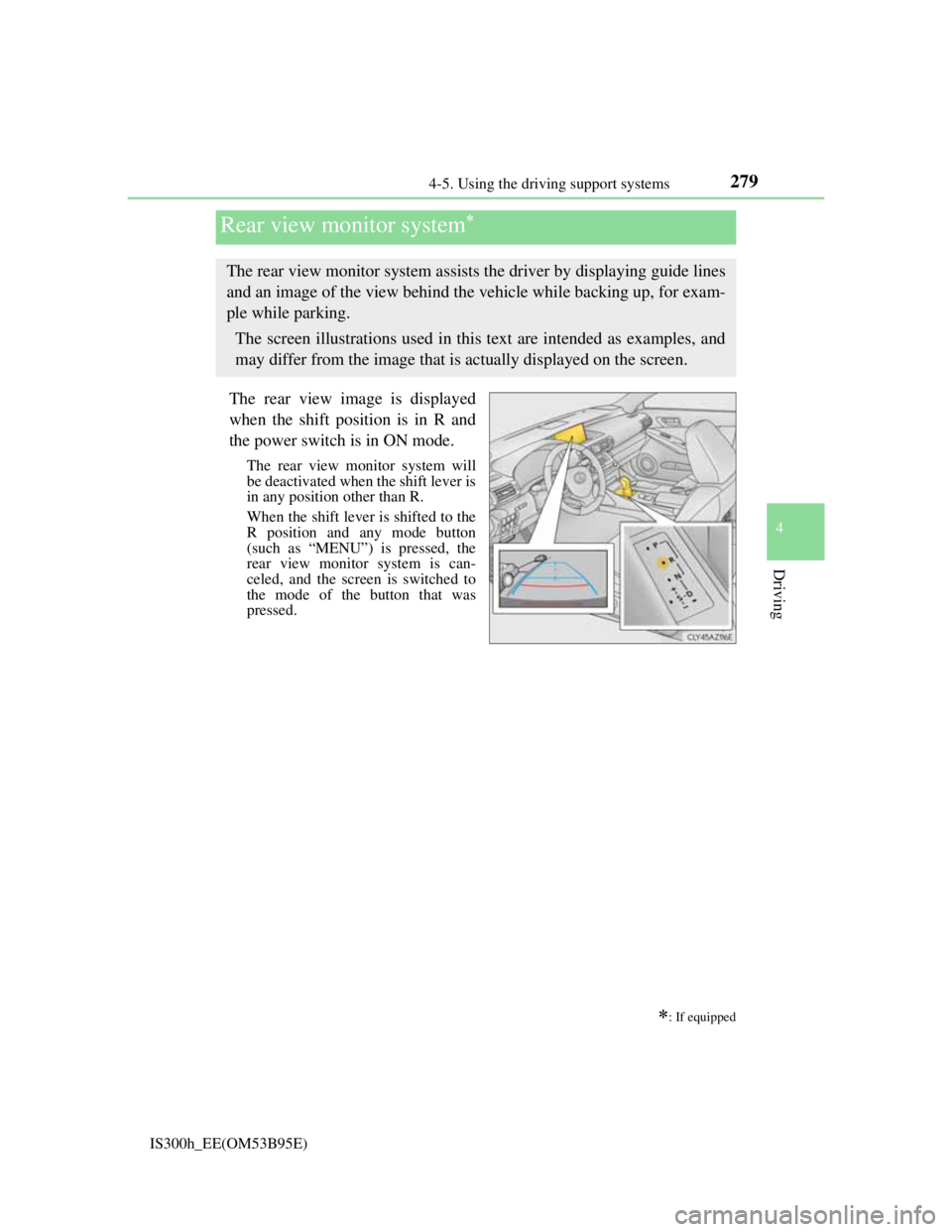
2794-5. Using the driving support systems
4
Driving
IS300h_EE(OM53B95E)
The rear view image is displayed
when the shift position is in R and
the power switch is in ON mode.
The rear view monitor system will
be deactivated when the shift lever is
in any position other than R.
When the shift lever is shifted to the
R position and any mode button
(such as “MENU”) is pressed, the
rear view monitor system is can-
celed, and the screen is switched to
the mode of the button that was
pressed.
Rear view monitor system
: If equipped
The rear view monitor system assists the driver by displaying guide lines
and an image of the view behind the vehicle while backing up, for exam-
ple while parking.
The screen illustrations used in this text are intended as examples, and
may differ from the image that is actually displayed on the screen.
Page 282 of 628
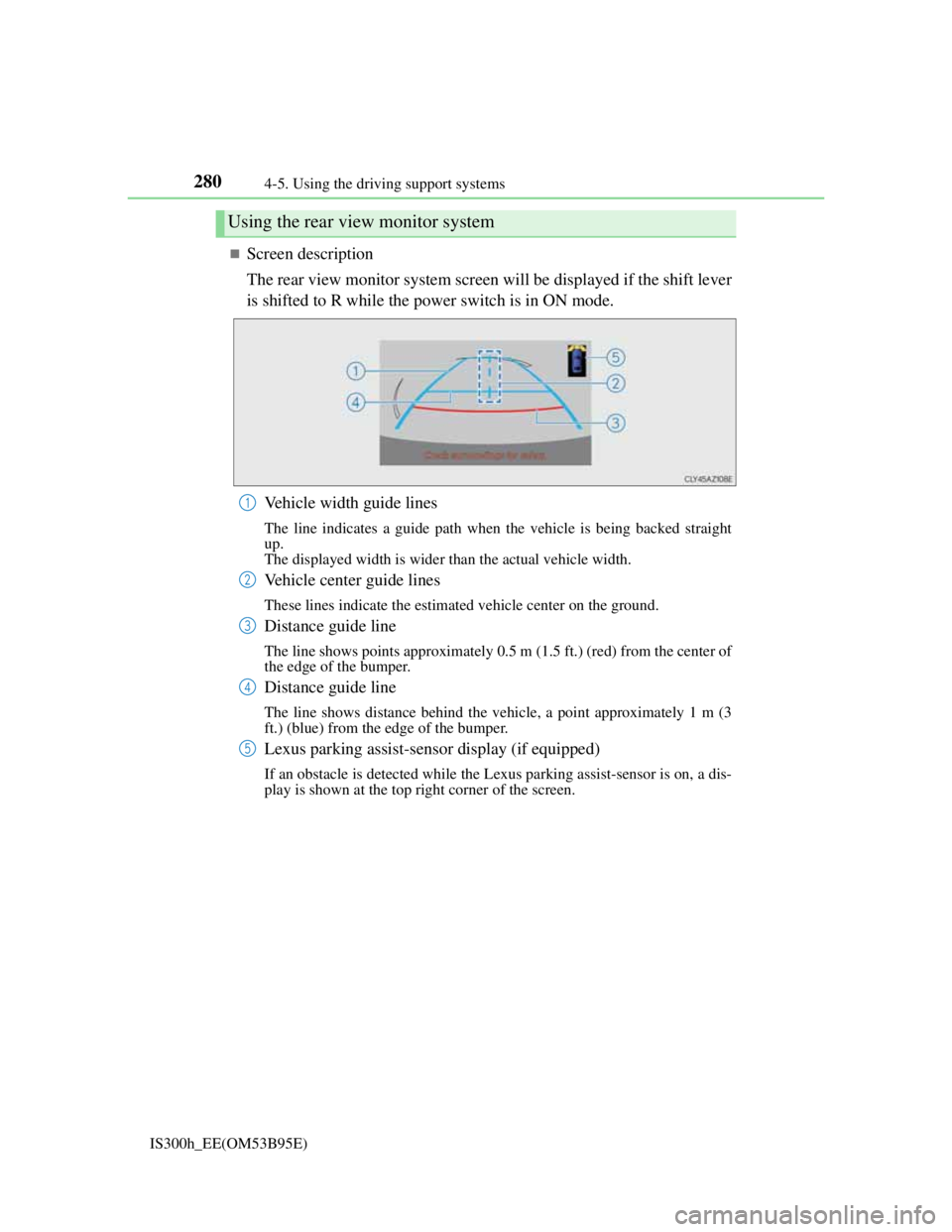
2804-5. Using the driving support systems
IS300h_EE(OM53B95E)
Screen description
The rear view monitor system screen will be displayed if the shift lever
is shifted to R while the power switch is in ON mode.
Vehicle width guide lines
The line indicates a guide path when the vehicle is being backed straight
up.
The displayed width is wider than the actual vehicle width.
Vehicle center guide lines
These lines indicate the estimated vehicle center on the ground.
Distance guide line
The line shows points approximately 0.5 m (1.5 ft.) (red) from the center of
the edge of the bumper.
Distance guide line
The line shows distance behind the vehicle, a point approximately 1 m (3
ft.) (blue) from the edge of the bumper.
Lexus parking assist-sensor display (if equipped)
If an obstacle is detected while the Lexus parking assist-sensor is on, a dis-
play is shown at the top right corner of the screen.
Using the rear view monitor system
1
2
3
4
5
Page 283 of 628
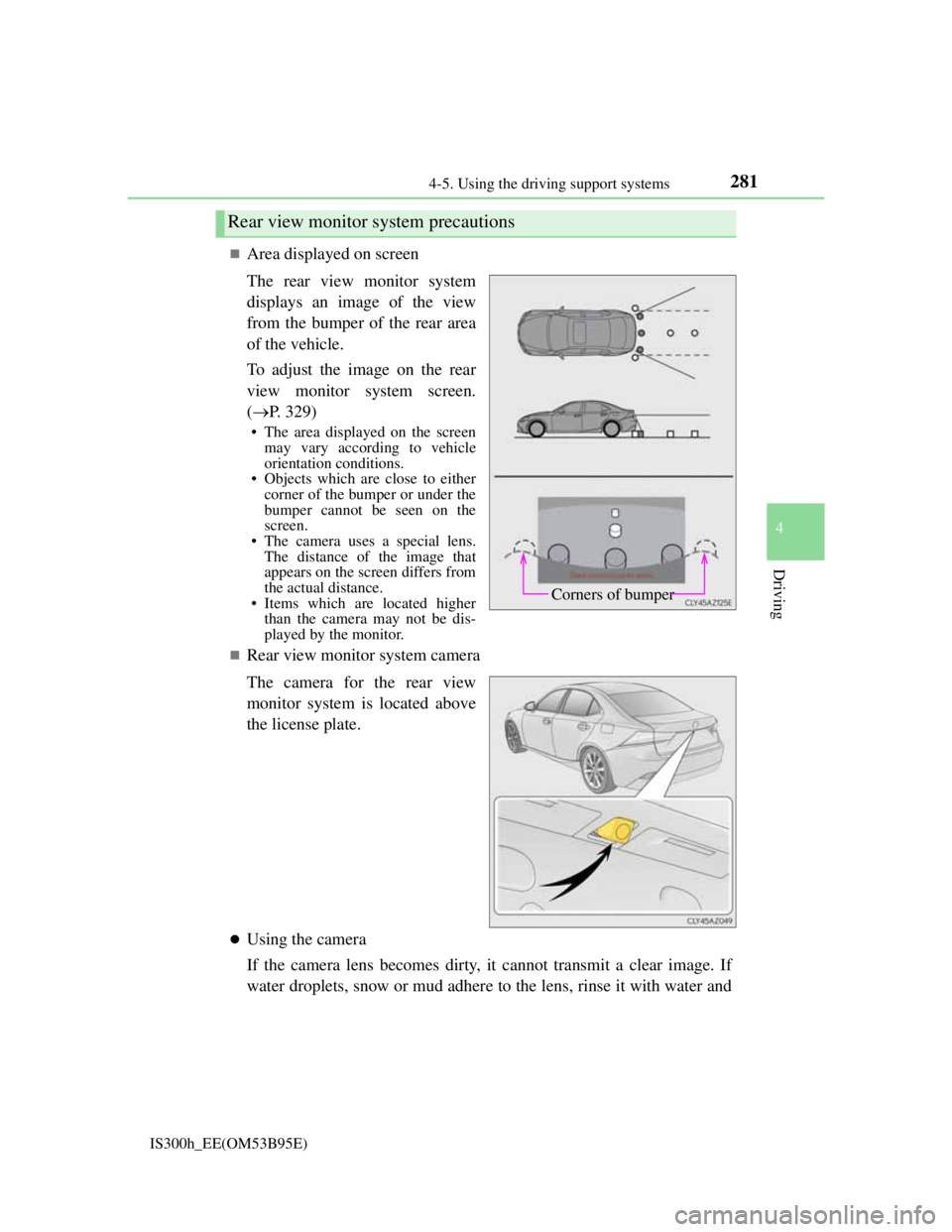
2814-5. Using the driving support systems
4
Driving
IS300h_EE(OM53B95E)
Area displayed on screen
The rear view monitor system
displays an image of the view
from the bumper of the rear area
of the vehicle.
To adjust the image on the rear
view monitor system screen.
(P. 329)
• The area displayed on the screen
may vary according to vehicle
orientation conditions.
• Objects which are close to either
corner of the bumper or under the
bumper cannot be seen on the
screen.
• The camera uses a special lens.
The distance of the image that
appears on the screen differs from
the actual distance.
• Items which are located higher
than the camera may not be dis-
played by the monitor.
Rear view monitor system camera
The camera for the rear view
monitor system is located above
the license plate.
Using the camera
If the camera lens becomes dirty, it cannot transmit a clear image. If
water droplets, snow or mud adhere to the lens, rinse it with water and
Rear view monitor system precautions
Corners of bumper
Page 284 of 628

2824-5. Using the driving support systems
IS300h_EE(OM53B95E)
wipe with a soft cloth. If the lens is extremely dirty, wash it with a mild
cleanser and rinse.
Page 285 of 628
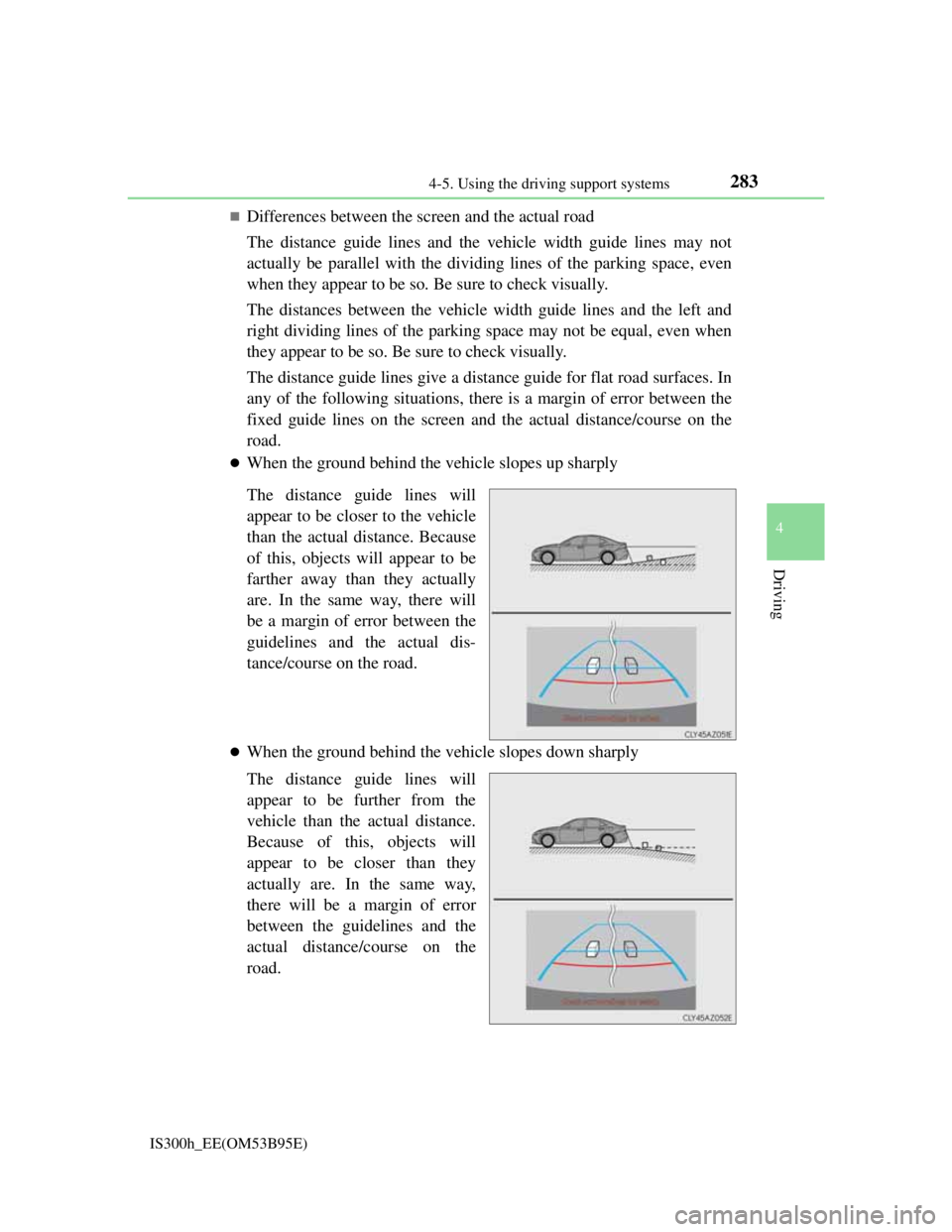
2834-5. Using the driving support systems
4
Driving
IS300h_EE(OM53B95E)
Differences between the screen and the actual road
The distance guide lines and the vehicle width guide lines may not
actually be parallel with the dividing lines of the parking space, even
when they appear to be so. Be sure to check visually.
The distances between the vehicle width guide lines and the left and
right dividing lines of the parking space may not be equal, even when
they appear to be so. Be sure to check visually.
The distance guide lines give a distance guide for flat road surfaces. In
any of the following situations, there is a margin of error between the
fixed guide lines on the screen and the actual distance/course on the
road.
When the ground behind the vehicle slopes up sharply
The distance guide lines will
appear to be closer to the vehicle
than the actual distance. Because
of this, objects will appear to be
farther away than they actually
are. In the same way, there will
be a margin of error between the
guidelines and the actual dis-
tance/course on the road.
When the ground behind the vehicle slopes down sharply
The distance guide lines will
appear to be further from the
vehicle than the actual distance.
Because of this, objects will
appear to be closer than they
actually are. In the same way,
there will be a margin of error
between the guidelines and the
actual distance/course on the
road.
Page 286 of 628
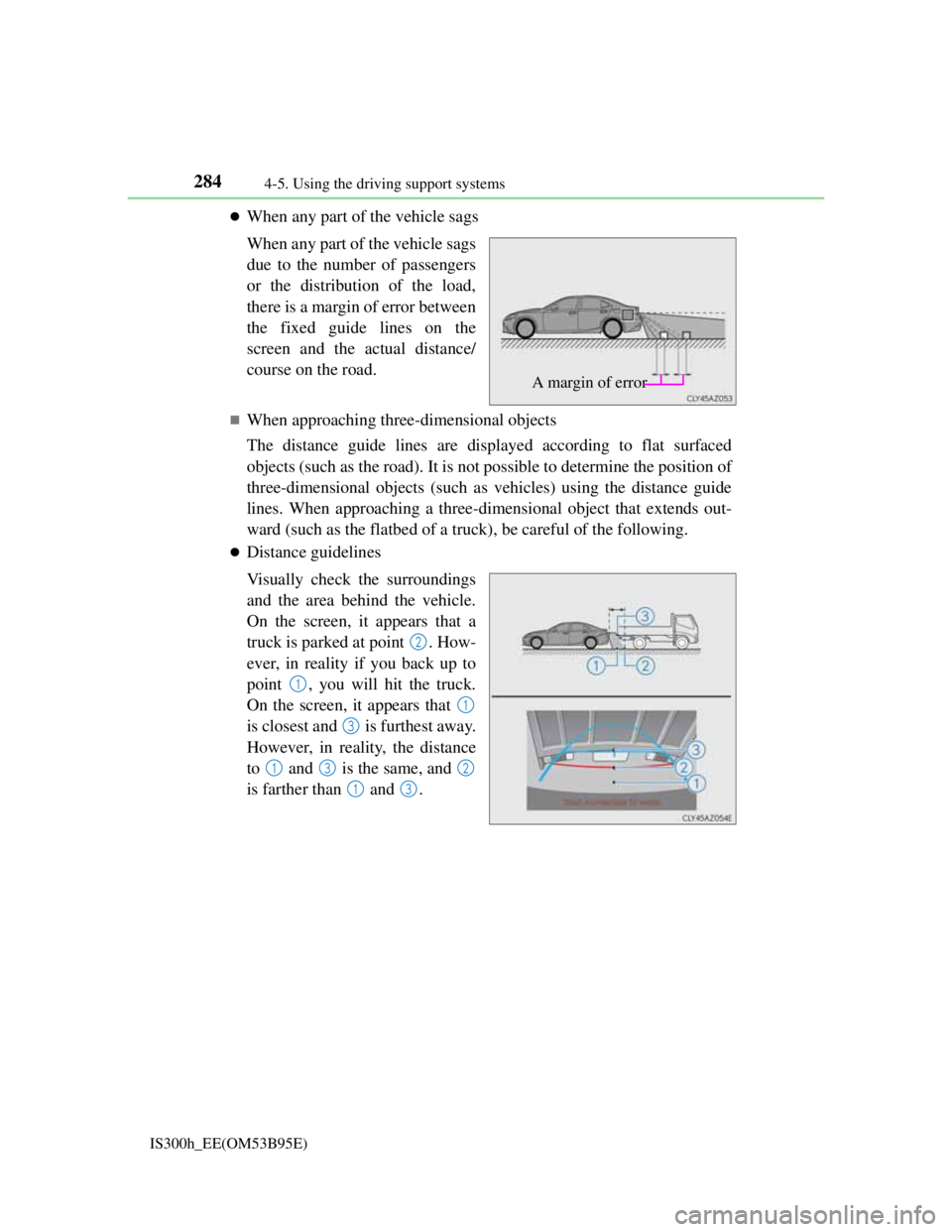
2844-5. Using the driving support systems
IS300h_EE(OM53B95E)
When any part of the vehicle sags
When any part of the vehicle sags
due to the number of passengers
or the distribution of the load,
there is a margin of error between
the fixed guide lines on the
screen and the actual distance/
course on the road.
When approaching three-dimensional objects
The distance guide lines are displayed according to flat surfaced
objects (such as the road). It is not possible to determine the position of
three-dimensional objects (such as vehicles) using the distance guide
lines. When approaching a three-dimensional object that extends out-
ward (such as the flatbed of a truck), be careful of the following.
Distance guidelines
Visually check the surroundings
and the area behind the vehicle.
On the screen, it appears that a
truck is parked at point . How-
ever, in reality if you back up to
point , you will hit the truck.
On the screen, it appears that
is closest and is furthest away.
However, in reality, the distance
to and is the same, and
is farther than and .
A margin of error
2
1
1
3
132
13
Page 287 of 628
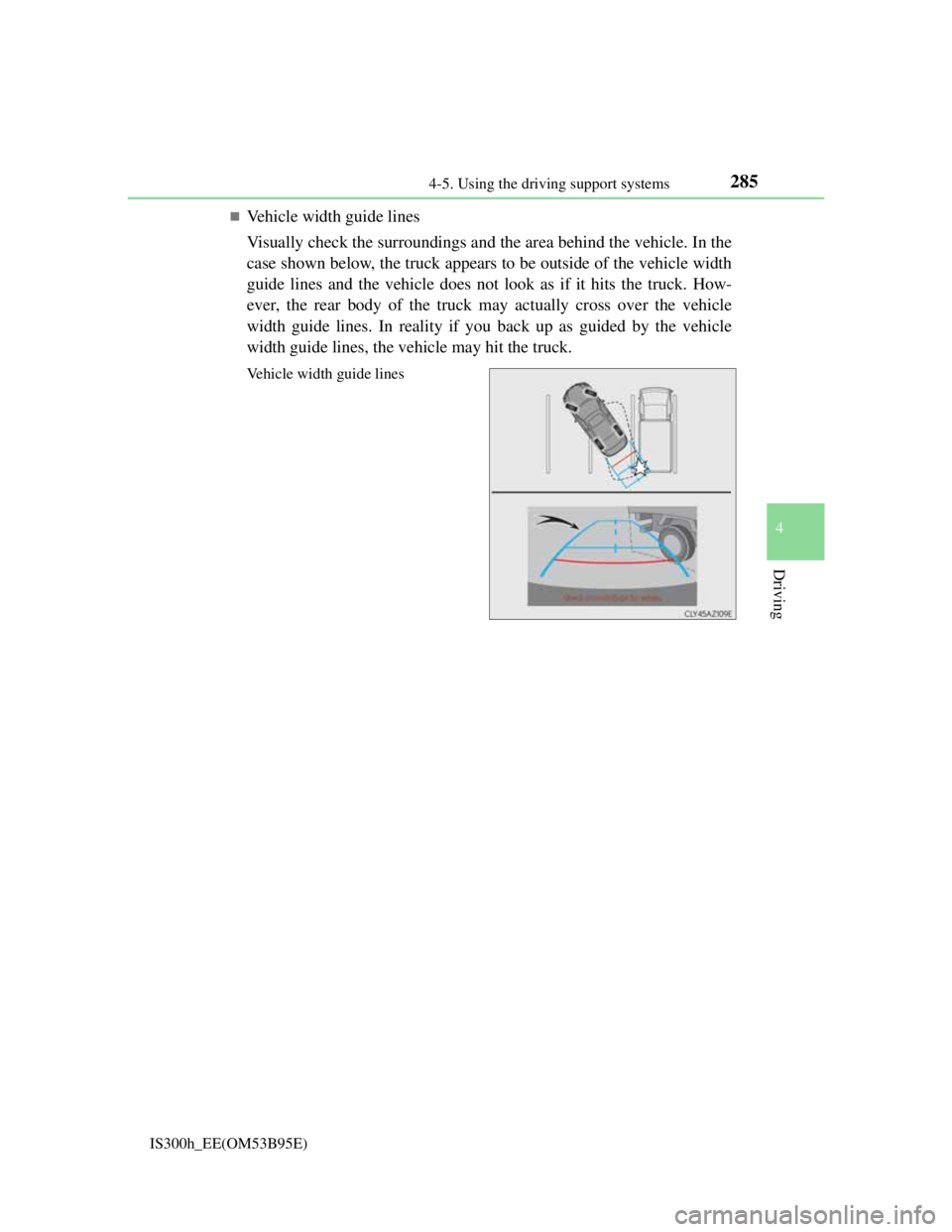
2854-5. Using the driving support systems
4
Driving
IS300h_EE(OM53B95E)
Vehicle width guide lines
Visually check the surroundings and the area behind the vehicle. In the
case shown below, the truck appears to be outside of the vehicle width
guide lines and the vehicle does not look as if it hits the truck. How-
ever, the rear body of the truck may actually cross over the vehicle
width guide lines. In reality if you back up as guided by the vehicle
width guide lines, the vehicle may hit the truck.
Vehicle width guide lines
Page 288 of 628
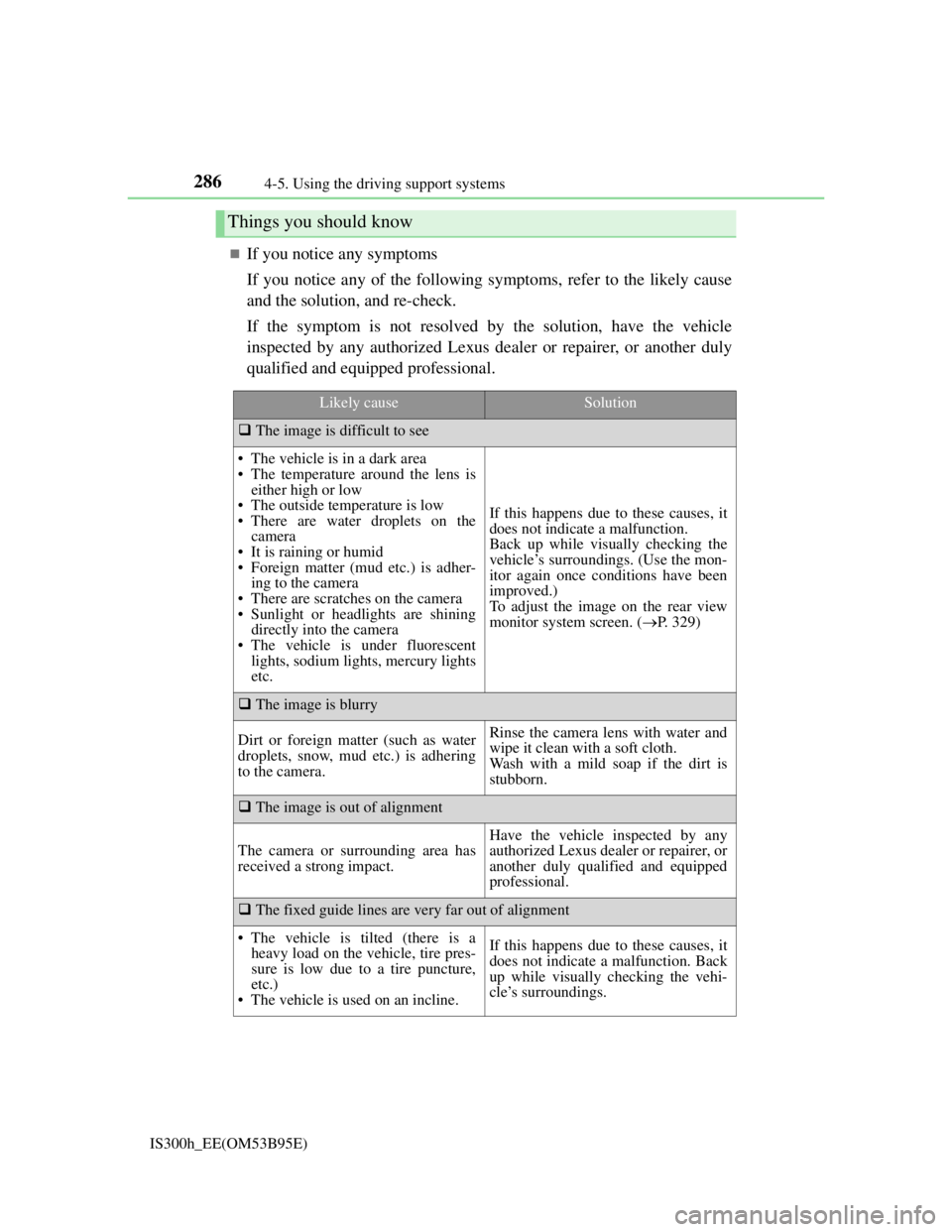
2864-5. Using the driving support systems
IS300h_EE(OM53B95E)
If you notice any symptoms
If you notice any of the following symptoms, refer to the likely cause
and the solution, and re-check.
If the symptom is not resolved by the solution, have the vehicle
inspected by any authorized Lexus dealer or repairer, or another duly
qualified and equipped professional.
Things you should know
Likely causeSolution
The image is difficult to see
• The vehicle is in a dark area
• The temperature around the lens is
either high or low
• The outside temperature is low
• There are water droplets on the
camera
• It is raining or humid
• Foreign matter (mud etc.) is adher-
ing to the camera
• There are scratches on the camera
• Sunlight or headlights are shining
directly into the camera
• The vehicle is under fluorescent
lights, sodium lights, mercury lights
etc.
If this happens due to these causes, it
does not indicate a malfunction.
Back up while visually checking the
vehicle’s surroundings. (Use the mon-
itor again once conditions have been
improved.)
To adjust the image on the rear view
monitor system screen. (P. 329)
The image is blurry
Dirt or foreign matter (such as water
droplets, snow, mud etc.) is adhering
to the camera.Rinse the camera lens with water and
wipe it clean with a soft cloth.
Wash with a mild soap if the dirt is
stubborn.
The image is out of alignment
The camera or surrounding area has
received a strong impact.
Have the vehicle inspected by any
authorized Lexus dealer or repairer, or
another duly qualified and equipped
professional.
The fixed guide lines are very far out of alignment
• The vehicle is tilted (there is a
heavy load on the vehicle, tire pres-
sure is low due to a tire puncture,
etc.)
• The vehicle is used on an incline.If this happens due to these causes, it
does not indicate a malfunction. Back
up while visually checking the vehi-
cle’s surroundings.
Page 289 of 628
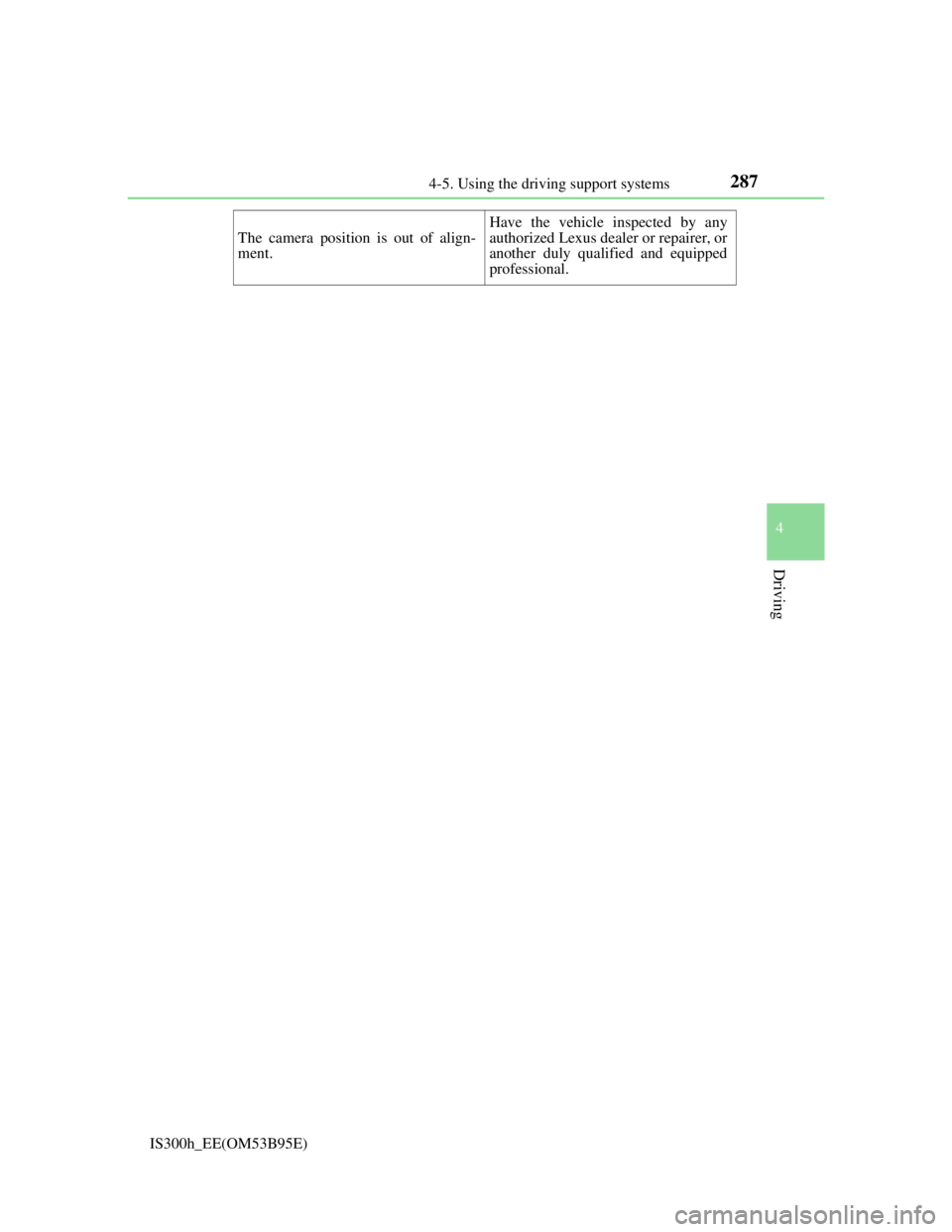
2874-5. Using the driving support systems
4
Driving
IS300h_EE(OM53B95E)
The camera position is out of align-
ment.
Have the vehicle inspected by any
authorized Lexus dealer or repairer, or
another duly qualified and equipped
professional.
Page 290 of 628
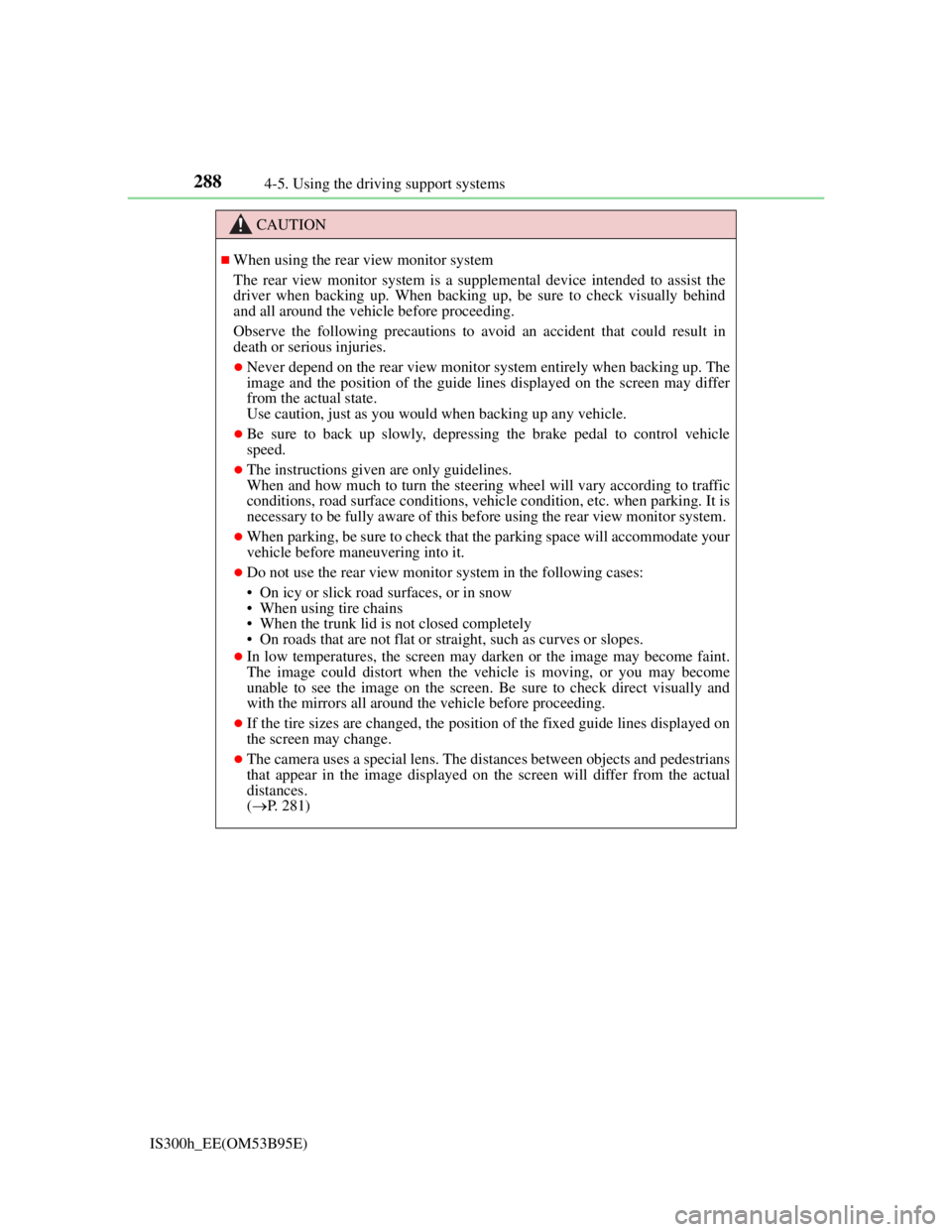
2884-5. Using the driving support systems
IS300h_EE(OM53B95E)
CAUTION
When using the rear view monitor system
The rear view monitor system is a supplemental device intended to assist the
driver when backing up. When backing up, be sure to check visually behind
and all around the vehicle before proceeding.
Observe the following precautions to avoid an accident that could result in
death or serious injuries.
Never depend on the rear view monitor system entirely when backing up. The
image and the position of the guide lines displayed on the screen may differ
from the actual state.
Use caution, just as you would when backing up any vehicle.
Be sure to back up slowly, depressing the brake pedal to control vehicle
speed.
The instructions given are only guidelines.
When and how much to turn the steering wheel will vary according to traffic
conditions, road surface conditions, vehicle condition, etc. when parking. It is
necessary to be fully aware of this before using the rear view monitor system.
When parking, be sure to check that the parking space will accommodate your
vehicle before maneuvering into it.
Do not use the rear view monitor system in the following cases:
• On icy or slick road surfaces, or in snow
• When using tire chains
• When the trunk lid is not closed completely
• On roads that are not flat or straight, such as curves or slopes.
In low temperatures, the screen may darken or the image may become faint.
The image could distort when the vehicle is moving, or you may become
unable to see the image on the screen. Be sure to check direct visually and
with the mirrors all around the vehicle before proceeding.
If the tire sizes are changed, the position of the fixed guide lines displayed on
the screen may change.
The camera uses a special lens. The distances between objects and pedestrians
that appear in the image displayed on the screen will differ from the actual
distances.
(P. 281)